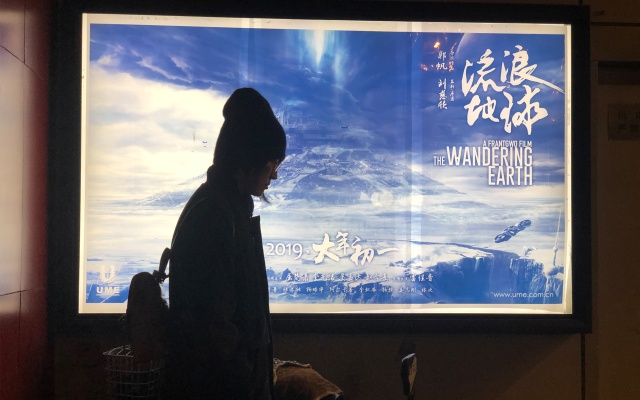The Wandering Earth is based on the novella of award-winning Chinese sci-fi writer Liu Cixin and has become the second highest-grossing film in Chinese history. Set in the near future, the solar system becomes uninhabitable and the earth’s population forms the United Earth Government and embarks on a plan to move the Earth out of the Solar System to the Alpha Centauri system. Planetary engines are built across the planet, underneath which are underground cities to house the human population. The engines, running on fusion power, stop the rotation the Earth and propel it to move away from the sun. As the film starts, the earth passes by Jupiter, whose gravitational spikes cause devastating earthquakes on the Earth and international rescue teams risk their lives to keep the earth engines running. However, Earth is drawn in by Jupiter’s gravitational pull to the point of no return. The artificial-intelligence-controlled international space station deems Earth impossible to save and turns on an escape mode to continue searching for inhabitable planets to populate. At this point, the young protagonist Liu Qi suggests igniting Jupiter’s hydrogen-rich atmosphere to propel Earth away, but the most powerful engine on earth falls short of igniting Jupiter. At this critical moment, astronaut Liu Peiqiang, Liu Qi’s father, destroys the command system in the space station and drives his spacecraft to the cloud between Jupiter and Earth, helping the ignition by sacrificing himself. Earth is propelled out of the orbit of Jupiter and continues its migration into another galaxy.
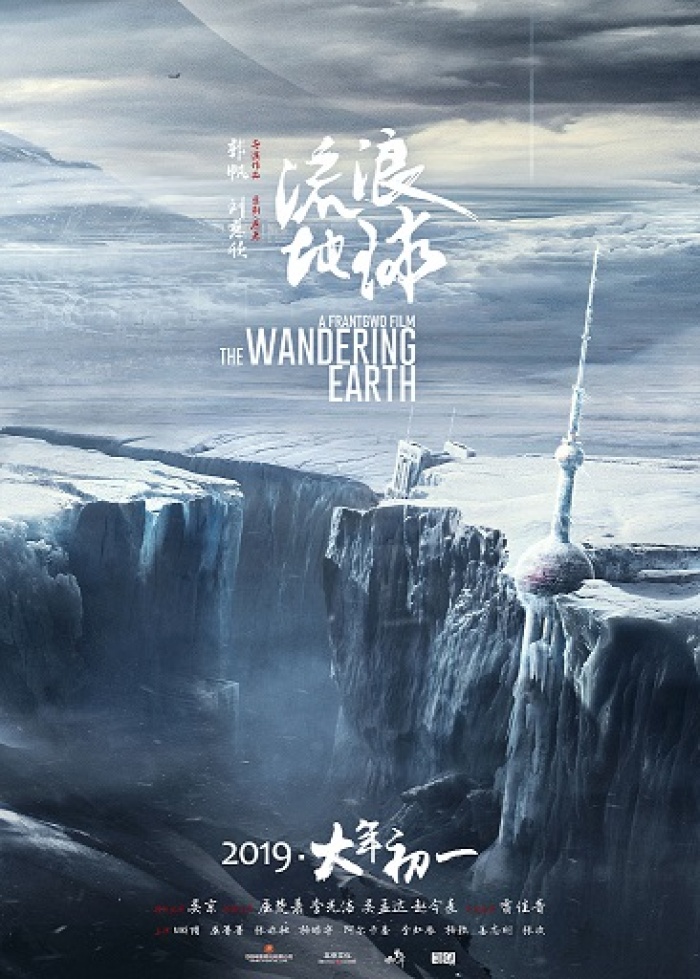
Plakat filmu z zamarzniętą Wierzą Szanghajską.
One of the most striking feats of this novel/film is the setup of the earth as a spaceship. As opposed to the biblical (and earlier Mesopotamian) image of Noah’s Ark or typical Hollywood narratives, whereby a few humans survive atrocities on earth by performing a miraculous and grand escape from trouble – based on an extensive idea of space so that the Earth/home can always be extended outward – The Wandering Earth turns everything around by taking an inward or intensive image of Earth. (In Liu Cixin’s novel The Three-Body Problem, there is a belief in Communism across different species, human and non-human alike, which the protagonist sees things more from a Buddhist perspective than from Christian one, while also using Noah’s Ark as a reference.) Almost every Chinese audience can relate this to the idea of 安土重迁, meaning the attachment to one’s land to the point of unwillingness to leave it behind, a deeply internalized idea thanks to the traditional Confucian and agrarian social order.
Liu is, however, not the first to propose this scenario of taking the Earth on an exile. Bao Tianxiao (1875–1973), a novelist and publicist, wrote a short story “世界末日记” [“Stories of the End of the World”] in which the moon is approaching the Earth, and people debate ways to save the planet. One of the proposals is exactly to use all scientific means to force the Earth to fly out of the Solar System.
One may recall a conversation between Mao Zedong and Yang Zhenning, Chinese physicist and Nobel Prize laureate who worked on nuclear reactions, in which Mao asked Yang if matters are infinitely divisible. The world of physics evinces the divisibility that conveniently fit Mao’s class discourses: class division, class enemy, perpetual struggles. He also said, though not drawing on atomic physics, “Take a footlong stick and remove half every day. In 10,000 years it will not run out. This is truth. If you don’t believe it, you may test it. If there is an end, there is no science.”
Now the trend has reverted. As the Earth has to go into exile, people need to work together more because they cannot afford to form fractions. (There are, however, fractions that favor escaping from Earth in the original novel, hence fan predictions for the sequel that they might launch more resistance movements from inside the Earth.) Mirroring the recent discourse 人类命运共同体, [“a community of shared future”], which first appeared in the 18th National Congress of the Communist Party of China in 2012, the question of global governance comes to the fore. The current discourse of “a community of shared future” is China’s answer to globalization and global cooperation in facing challenges such as climate change and terrorism. In various global summits, Chinese leaders emphasize both concrete policy issues such as development, security and sustainability, as well as intangible ties such as through culture. Can The Wandering Earth forecast, albeit in an extreme and speculative scenario, what global governance might look like in the future?
The united Earth government is clearly the highest organ of global governance. Its logo is an adaptation of the United Nations, though there is no further explication in the film whether it reproduces the governing structure and therefore the fallacies of the UN. The existence of such an institution gets many audience members wondering about its functional details, such as why the official language is French (to be sure, that is one of the UN’s official languages). At any rate, to have a government that speaks for all of humanity makes up a powerful image. (All of humanity, however, has been reduced by half by then due to a limited infrastructure, which stirred discussions in China. One columnist adamantly asks, is it really necessary to compromise half of the Earth’s population?) The rescue of the power stations indeed takes international participation with national divisions, such as the Japanese, Filipino, Russian, Chinese teams coming from their respective home bases – driving on the ice-locked surface that once covered their respective countries. Here, also the details of the administration of the post-nation-state Earth citizens, their education, and how they preserve their cultural identities would be of interest – the beginning of the film shows the typical features of Chinese New Year being reproduced in the underground city. What is lacking in the film is an earnest rethinking of the social system beyond governance as well as questions such as if the current economic and social productive relations endure, what kind of economic and exchange system is in place, what does education mean in the post-apocalyptical era, and if families are organized in the same way honoring the same values as ours do, granted that our social values change radically generation to generation. In the original novella, there are passing hints at the future societies: astrophysics and engineering become the concern of everyone while arts and philosophy courses are barely taught, love is informal if ever felt, though couples do marry and reproduce, everyone is subject to the operation under the guidance of the (technocratic) United Earth Government – an unsettling nod to Brave New World and somehow lacking the same level of rigor and wit as seen in the astrophysical imaginations.
Yet despite the purported global governance, parts of the film rather lack genuine cultural confidence with an anxiety that constantly tries to prove and justify itself. For example, the half-Chinese-half-Australian hooligan and accidental crew member has to bang on his heart saying “I have a Chinese heart” in a Beijing dialect to prove his worthiness to be on the team. Bits like this are usual tactics to appeal to a domestic audience accustomed to the genre of patriotic films. This mentality contrasts interestingly with tianxia, the historical world order in Confucian society, which means “everything under heaven” whereby the universal emperor enjoys the lofty solemnity and can allow all kinds of differences to co-exist. Tianxia historically denotes a hierarchical world system whereby the Chinese Empire was at the center and the countries on the periphery would enter into a tributary relationship with China. These relationships relied on the peripheral states paying tributes to China and symbolically acknowledging the central place of the Emperor, often through highly elaborate performative rituals. In return, the states bestowed lavish gifts asymmetrical to their own offerings, and military protection when needed. The deeper Confucian roots of tianxia reveal a world order in which the universal emperor acts according to the cosmological and moral order of heaven, thereby embodying the mandate of heaven. According to the dynamic reading of Confucianism, the universal king can be challenged if he does not fulfil his role, and the mandate of heaven can favor another person or even epoch (which was the case made by the Japanese in the 1930s and 1940s). The political and geopolitical consequence was that the tributary system enabled greater security for those involved without engaging in arms races.1 In this way it contributed to the peaceful coexistence of different peoples and polities. The recently revived discourses on tianxia and “a community of shared future” make good bedfellows, both positing politics on a level of cultural consciousness, yet remaining vague in indicating ways of getting there.
Which is tradition and which speculation?
The Wandering Earth paints a dystopic picture of the Earth that is excruciatingly recognizable but hopelessly irredeemable. The sight of Shanghai’s once-spectacular Pudong skyscrapers deadlocked in the ice mountain, and the wishful exchanges between the Chinese and Russian astronauts – that their children can witness the day when Lake Baikal melts again and they can fish there, are poignant alarms to what climate change might lead to, if not theoretically proven, then at least popularly felt.
There is no better way to forge a “community of shared future” than through such catastrophic images. Cultural theorists since Marcuse would properly honor the place of popular culture in transforming subjectivity, but few could have anticipated the velocity of the recent sci-fi boom in China and its social potential. To assess this, we will go into the history of sci-fi, popular science (“science non-fiction”), education, in tandem with historical and recent scientific developments in China.
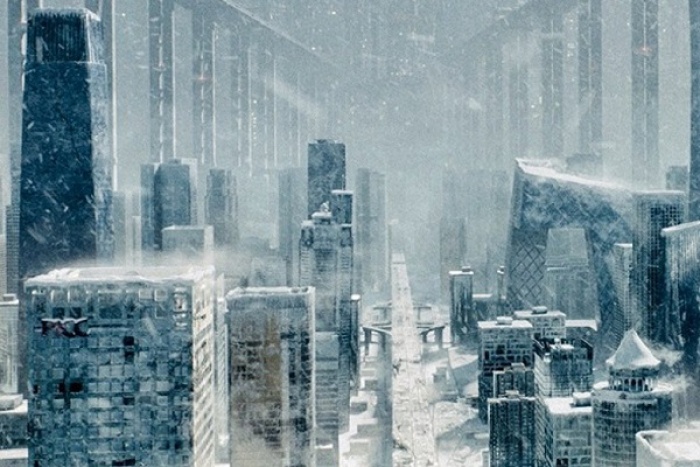
Klatka z filmu przedstawiająca zamarznięty Pekin.
How do speculation and policy go together? Science fiction has inspirational functions but needs more mediation to provide useful guidance to the development of science (non-fiction). The European Union has identified the future major technological focuses on automation, AI, ecology technology, while China writes its ambitions into its five-year plans. Three years in a row, AI has appeared in the Chinese government plan, and it has been widely discussed how its wide range of applications covers industrial production, medicine, caring for the elderly, education, culture, and sports. When it comes to how the policy of technological development trickles down into society, general science education fills the gap between the policy and public understanding, which plays out rather differently in Europe and China. In China, even a retiree has an idea of what a blockchain is, and programming is taught in primary schools, even kids are widely encouraged to play with apps designed to develop their programming skills (which is not uncontested).
Science fiction is on the speculative end of the general science education. The craze over Star Trek, for example, came out of a time when space explorations were making headlines, the tacit background being the space race and the Cold War. The frontier of space does not seem to hold the promise it once was thought to have, while the cut-throat competition between the world’s major powers, the U.S., China, and to some extent, Russia, have moved to communication, computation, and biological technologies.
Yet is there a way for the speculative to help shape the future? This is where a fine balance could be experimented with, at the intersection between the arts and techno-socio-political processes, emergence of new social relations and modes of production could be mediated in the fashion of “crossing the river by feeling the stones”, a proverb of wisdom formulated by Deng Xiaoping when describing how the reform in China ought to take place.
There has been a surge of interests in Chinese technological culture and philosophy, the core question remains, does traditional thinking warrant different ways of going about technology? Here, we could investigate the notion of “cosmotechnics” proposed by Yuk Hui, as “the unification between the cosmic order and the moral order through technical activities”, which should overcome the conceptual dualism of technics and nature.2 Cosmotechnics enters into a fruitful dialogue with philosopher Gilbert Simondon and anthropologist Tim Ingold, who attempt to reground the human in the world, thereby reuniting the figure and the ground. Cosmotechnics, in this way, can be seen as a reunification of technics (器 Qi, tools) and cosmos (道 Dao, the way, order). Hui then makes a plea for the regrounding of technics in cosmology, following Simondon and Leroi-Gourhan, who argued that the experience of technics is related to and partially conditioned by cosmology, and that, in the first place, technology is a bifurcation of magic.3
We could also consider the legacy of traditional science and technology culture or myths in today’s technological advancement. The Chinese Lunar Exploration Program is named the Chang’e Project, after a lady who in traditional myth has overdosed on a Daoist elixir and flown to the moon where she remains for all to see. Tiangong, China’s space laboratory, means Heavenly Palace, again drawing from traditional Daoist and folklore stories. The Quantum Experiments of the Space Scale project is named after Mozi, an ancient Chinese philosopher, who foresaw the theories of atoms, particles, and formulated a very primitive theory of astrology. We may quote cosmism in the history of Soviet space travel (more than we could in the Apollo program), in the words of scholar Siddiqi, “the modern rocket with its new Communist cosmonaut was conceived as much in a leap of faith as in a reach for reason.” 4 Siddiqi argues that cosmonautics and the space fad, which also started a religious-mystic kind of enterprise and idea at the early 20th century, lost its religious overtones when the actual space trips came about during the Cold War.5 Here the Chang’e, Tiangong, and Mozi are cultural tropes that may or may not inspire scientific missions.
It might all be techno-orientalism in a new dress if science and technology scholars are looking for a distinctive ‘Chinese way’ – whether drawing on the traditional or speculative aspects of the culture – in contemporary scientific developments. It is perhaps not the culture of science and technology that is different, rather than the underlying cultural and value system itself. Here, an example that transpires time-space is telling. In the original novella of The Wandering Earth, in the event of emergency evacuation, people automatically follow an order that prioritizes the younger over the older of the Earth’s populace. An important pretext is mentioned elsewhere that memories can be genetically transferred (pace embodied theory and the current level of epigenetics) from generation to generation. Again, rationalism and scientism are at play in drawing out this mechanistic image of the human. Compare this with MIT Media Lab’s Moral Machine, designed to survey people’s decisions on the self-driving car’s “trolley question.” In one of the variations the question goes: if two pedestrians are on the road and a speedy car will inevitably hit one of them, should the car kill an elderly person or a young person? Whereas participants from individualist countries like France are more likely (66 percent) to spare the young over the old, collectivist cultures like Taiwan (77 percent), China (72 percent), Korea (58 percent) are more likely to spare the old over the young.6
It may seem that Confucian societies are prone to respect the elderly. Yet again, Confucian scholar Ji Xiaolan (1724–1805) gives another twist to this ethical quandary. A widow lives with her mother-in-law and her son. One day, both of them fall into the river, following the Confucian doctrine of respecting the elderly, she saves her mother-in-law. As the mother-in-law learns that her grandson is dead, she is desperate that her family lineage is over and jumps into the river to kill herself. Ji is sympathetic to non-orthodox thinking.
Each era or culture faces its own problems and has to define its value system. In this sense, The Wandering Earth has offered a social imaginary and value system that is based on a mechanical view of the human set in the distant future. I wonder, what would happen, if there was a public culture of sci-fi that instigated imaginations and discussions of freedom, social relations, economy in ways that radically depart from the current norms and fallacies?
Divergent paths: Science non-fiction
Instead of Silicon Valley solutionism or Hollywood heroism all based on distant futures (both are shared by their Chinese counterparts), a refocus on how we get to the futuristic scenarios is in good order. This is where the science non-fiction comes in.
In his book How Not to Network a Nation, Benjamin Peters traces the history of cybernetics in the Soviet Union and its attempts to utilize it for a nationwide network that would balance demand and supply in real-time. As much as it seemingly contradicts the centralized scheme of the Soviet-planned economy, its goal was to boost productivity overall, and would therefore have been in alignment with the socialist regime. The fierce competition and self-interests among the numerous research institutes, technocrats, and specialists failing to work with each other led to the abortion of this nationwide project.7
The socialist bloc in general followed the idea of using science to transform man, a discourse belonging to the Soviet ideological purview. Now we look back with a sense of incredulousness at movements that propagated for, and experimented with, tuning human labor with machines in the case of Alexei Gastev, or in the Soviet and Chinese cybernetic project. While at the same time, the popular science education is deeply engrained in us. There is an admittedly melancholic tone to socialist science centers, which we frequented on school trips and during holidays. At the same time there is an unmistakable air of aspiration and enticement too. Artist Meng Site’s paintings capture this complex sensation, combining the hope and disillusion through the distributing faceless figures in the space of science centers.

Meng Site, Muzeum gwiezdnego pyłu, dzięki uprzejmości Space Station Gallery.
Qian Xuesen, Chinese aerodynamicist trained with Theodore von Karman, who later oversaw China’s nuclear weapon, missile, and space program, was also a propagator of cybernetics since the 1950/60s. Wang Hongzhe compares China’s cybernetic program with that of the United States’ and Soviet Union’s and points out its rootedness in the “mass movements” in China. In the Soviet Union, the mass also engaged in popular science projects by building amateur planes and cars, documented here in the childhood photo of Korean-Kazakh artist Alexander Ugay and his works. However, China never had the technocratic class the Soviet Union did. Chinese scientists engaged cybernetics, mathematics, and data sciences during the Great Leap Forward and the Cultural Revolution periods in concrete production sites such as villages and factories on the most local levels, amounting to political mobilization through technology. While at the same time, nationwide centralization was never achieved in Maoist China (and the eras to follow) in order for any cybernetic projects to scale up. The equal emphasis on high-end rocket science and grassroot technological politics – the mass line – was the distinctive Chinese way of technological development until the end of the 1970s.
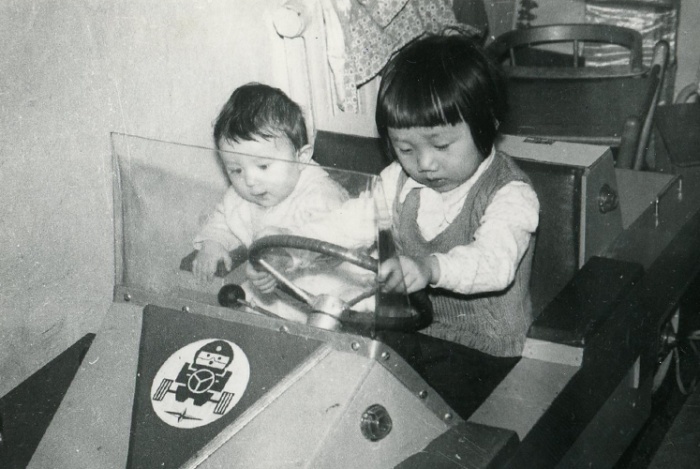
Alexander Ugay z ojcem-budowniczym samolotów amatorskich i kolażem Więcej niż marzenia, mniej niż rzeczy, dzięki uprzejmości Aspan Gallery.
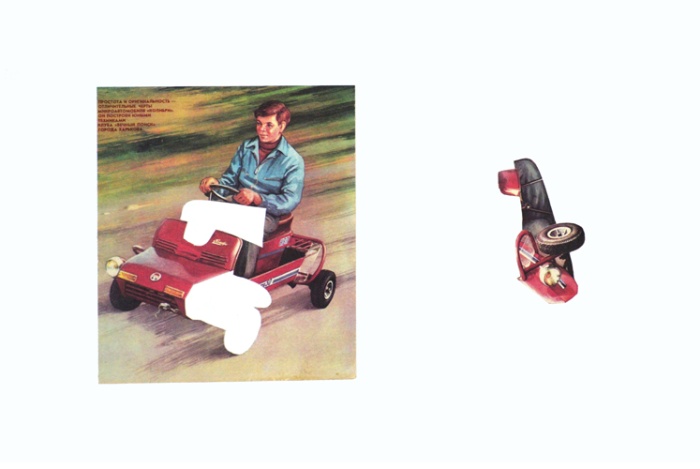
Alexander Ugay z ojcem-budowniczym samolotów amatorskich i kolażem Więcej niż marzenia, mniej niż rzeczy, dzięki uprzejmości Aspan Gallery.
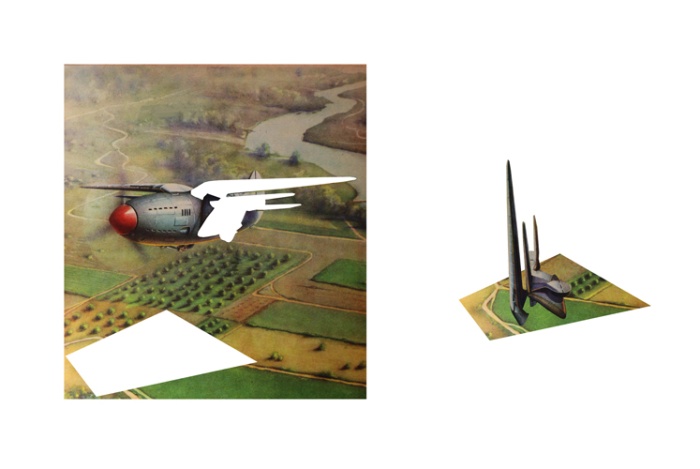
Alexander Ugay z ojcem-budowniczym samolotów amatorskich i kolażem Więcej niż marzenia, mniej niż rzeczy, dzięki uprzejmości Aspan Gallery.

Alexander Ugay z ojcem-budowniczym samolotów amatorskich i kolażem Więcej niż marzenia, mniej niż rzeczy, dzięki uprzejmości Aspan Gallery.
After initiating the Open Reform process, Deng Xiaoping pulled the brake on heavy military industry and with it, ousted the political mobilization part from technological development, kickstarting China’s economic rebuild by prioritizing consumer industries and by allowing decentralized developments driven by self-motivated local agents. Deng Xiaoping’s “科学是第一生产力” [“science is the first productive force”] became the motto, supplanting the place of revolutionary subjects. At this juncture, Qian Xuesen suggested using cybernetics to study agriculture and ecology – not unlike his Western peers, as well as supernatural functions of the human body in Qigong and other practices. Even as China moves closer to the liberal economic model of the West, throughout the four decades in the last century, the adamant emphasis on the role of the human agent has always shaped the technological politics as opposed to taking the universalism of technology as overriding political formations.8
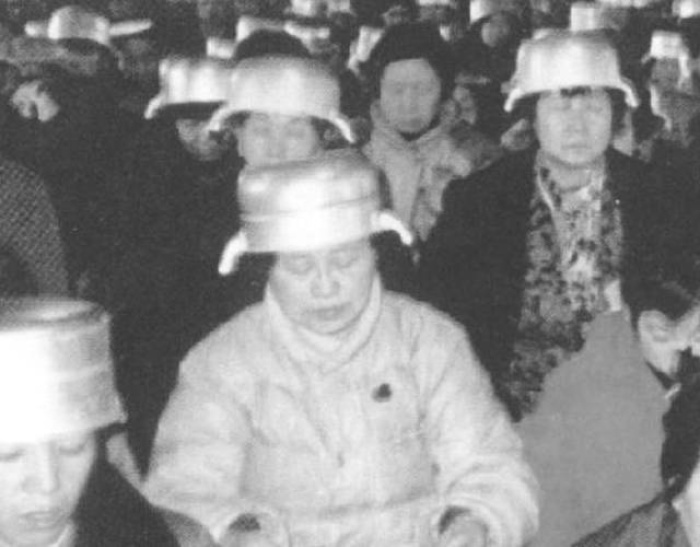
Grupa badaczy Qigongu eksperymentuje z „kosmicznym wokiem”, który ma odbierać energię kosmiczną, Pekin, 1993. Źródło.
Despite all the shifts on the industrial front, the cultural residue of mass technological politics seems to be left dangling, and formed the entire imaginary of the generations that grew up from the 60s to the 80s. Liu Cixin himself, too, is a product of his time, and his best-selling novel The Three-Body Problem, is set in part in the 60s and 70s, in a solitary extra-terrestrial research center in China.
Back to reality
Having mapped the converging and different paths to science and technology, what is the reality? Where is China in science development today?
From 2011–2015, China allocated about 5% of its scientific research budget to fundamental sciences and 85% to research and development, compared to 17% and 64% respectively in the United States. The expenditure on operation and maintenance is also significantly lower than the international norm, resulting in excruciatingly substandard welfare for the scientists involved in daily operations.9 The recent case of the Large Optical/Infrared Telescope, or LOT is telling. Upon completion it will become the world’s largest telescope and is expected to give Chinese astronomers a head start in exploring the early universe and exoplanets among other scientific goals. There has been disputes between the two design schemes, one with a standard three-mirror optic system originally chosen as the winning design, and another with a four-mirror design which may not guarantee the same precision and is costlier. The second design was later chosen after a second review. Scientific objectivity gets mixed with nationalist sentiment (the original review involved foreign experts) and vexed interests in such fundamental scientific missions. Chinese readers may cheer at the grand feats of Liu Cixin, yet on the front of fundamental sciences, there is still a long way to go.
The Wandering Earth and Liu Cixin’s sci-fi novels open many doors to celestial imaginations, at the same time, they cast our self-understanding and self-imagination in a new light. Where sci-fi ends is where science non-fiction begins. Or is it? As sci-fi scenarios become increasingly real in the devastating effects of the climate change, and the sentiments they provide become more shared – either heroism or escapism, we need more than technology itself to redeem us from the deteriorating condition of the Anthropocene. Historical references are plenty, including the principle of moderation and the law of change and non-orthodoxy in philosophy, the fervent mass mobilization of sciences, and what seems to be the only unshaken way – scientism. But if speculative thinking tells us something, it tells us even scientism can fall short, and there, the stardust of the humanities can once again shine.
BIO
Mi You is a curator, researcher, and member of the academic staff at Academy of media Arts Cologne. Her long-term research and curatorial projects takes the Silk Road as a figuration for deep-time, decentralized, and nomadic imageries. Under this rubric she has curated a series of performative programs at the Asian Culture Center Theater in Gwangju, South Korea, and the inaugural Ulaanbaatar International Media Art Festival, Mongolia (2016). Her academic interests are performance philosophy, science, and technology studies, as well as political philosophy. Her writings appear in Performance Research, PARSE, MaHKUscript, Yishu, and LEAP, among others. She is fellow of Alexander von Humboldt Foundation, and serves as director of Arthub (Shanghai) and advisor to The Institute for Provocation (Beijing).
The author would like to thank Zhao Yang, Andreas Niegl, and Zian Chen for the engaging conversations that helped shape this article.
[1] Kang, David C. (2010). East Asia Before the West: Five Centuries of Trade and Tribute. New York: Columbia University Press. p. 55.
[2] Hui, Yuk (2016). The question concerning technology in China. An essay in cosmotechnics. Falmouth: Urbanomics, pp.19–20.
[3] Ibid., pp.203–223.
[4] Siddiqi, Asif A. (2008). ‘Imagining the cosmos: Utopians, mystics, and the popular culture of spaceflight in revolutionary Russia.’ Osiris: Intelligentsia science: The Russian century, 1860–1960. no. 1. p. 260.
[5] Ibid. p. 288.
[6] https://www.technologyreview.com/s/612341/a-global-ethics-study-aims-to-help-ai-solve-the-self-driving-trolley-problem/
[7] Peters, Benjamin (2016). How Not to Network a Nation: The Uneasy History of the Soviet Internet. Cambridge, MA, the MIT Press.
[8] Wang, Hongzhe (2016). ‘中苏控制论革命与社会主义信息传播技术政治的转型:一项基于文献的历史比较 The Political Turn in Chinese and Soviet Cybernetics and Socialist Information Technology: A Historical Comparison’, 区域 Remapping, no.1. Beijing: Social Sciences Academic Press.



